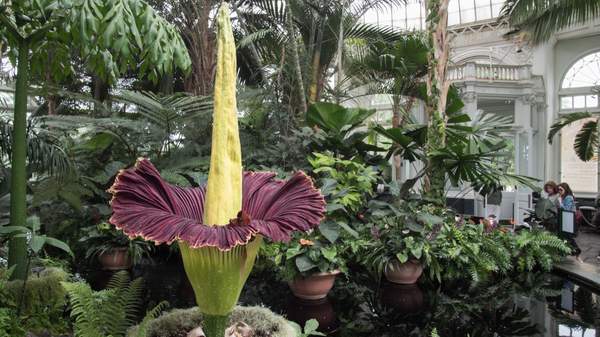Overview
Some say it smells like rotting flesh. Others detect a hellish whiff of sulphur or the unmistakable funk of cheesy feet. What everyone who has had the chance to smell the Bunga Bangkai — also known as the Corpse Flower — can agree on is that the odour is one of the rankest produced by any plant in the world.
Its spectacular stinkiness aside, the Corpse Flower is also remarkable for its size and rarity. Native to the rainforests of western Sumatra, this endangered plant produces just a single flower every few years, which can tower to 3.5 metres in height — the largest of any plant. Once unfurled, the flower opens for just 24 hours before wilting, making it not only one of the planet's most striking botanical wonders but also one of its most fleeting.
It is all but impossible to predict how long a Bunga Bangkai plant will go between blooms, but various specimens at Sydney's Royal Botanic Gardens have flowered in 2004, 2006, 2008 and 2010. Now, after a decade-and-a-half hiatus, a Corpse Flower is preparing to bloom once more for Sydneysiders.
On Friday, January 10, the Royal Botanic Gardens released a statement saying its horticulturalists had noticed the tell-tale signs that one of its Bunga Bangkai plants — nicknamed Putricia — might be entering the flowering stage. Since then, the flower has sprouted and grown more than 40 centimetres, adding around 10–15 centimetres in height every day.
Describing the plant's extraordinary stench, the Royal Botanic Gardens Manager of Volunteer Programs, Paul Nicholson said: "If you've got some wet teenage socks, throw that into a blender, then you get some cat food you've left out in the sun, whack that in your blender, and then get some day old vomit. Put that in the blender, blend it all up, rip the lid off. That's the kind of smell you're getting."
And yet, despite this olfactory assault, there is an undeniable beauty to the mighty Corpse Flower, which has a leathery, arterial-red frill, known as a spathe and a large, pointed growth, the colour of bleached bone, at its core. The exact date the bloom will begin is yet to be determined, but the spadix (the large pale spike in the centre of the plant) is growing rapidly. Once this spurt in growth slows, in all likelihood within the next week or so, the plant will be moved to a public area of the gardens for Sydneysiders to see (and smell), but also so that insects, attracted by the scent of carrion, can pollinate the plant, completing its life cycle and resetting the countdown until another Corpse Flower gifts Sydney with its famously foul fug.
